An extensive City Walk in Venice
Small Streets, Bridges, Churches, Plazas, Museums, Schools, Palaces, Buildings, Shops etc.

In Venice, there is a whole range of significant monuments and sightseeings that can be sequentially pounded as in any other city too. But the main attraction of Venice is clearly locatable and findable; it is the oldtown itself with the six districts. The oldtown of Venice is like a huge labyrinth of stone with wide streets, narrow alleayways, plazas, bridges and of course impasses.
It would not make sense if I now determined an ideal route through the labyrinth, as such a route is on one hand difficult to describe and on the other hand it would be very difficult to follow it. This is why I give a lapidar tip for the viewing of the actual Venice: Getting into the labyrinth of stone and walk aimlessly up to the moment when the feet start to ache. The experience will be unforgettable.
What is expecting one in the huge labyrinth of Venice? The city is full of small shops, restaurants, fashion and jewelry shops. From the souvenir for the tourists up to the posh tie, everything is available. But one should never look for something in particular, as, as known, one will not find it in a labyrinth. And one should not try to memorize a shop or a restaurant at all, as it will be certainly not be found any more. How many times we discovered a nice trattoria to which we wanted to go in the evening - we never found it again.
Sometimes one really feels lost in the narrow alleyways of the oldtown, and sometimes an alleyway unexpectedly ends at a channel or a house wall and one simply has to turn. And sometimes, a narrow alleyway unexpectedly ends at a nice place with a glorious wall covering of a church in the foreground. Then, one first has to scroll the city map in order to find out somehow where one actually is and what is actually in front of one.
One thing is very difficult: those who want to walk from A to B according to the city map has possibly to take a lot of detours, as between two points, most of the times there is a channel in between. There are indeed some few hundred bridges in the city, but most of the times the bridge is missing at the place where it is the most needed.
All this sounds confusing and complicated, rather as a big challenge or an adventure as a romantic city viewing. It is not like that, as one is not completely lost in the entanglement of streets and channels. One repeatedely finds some signpostings at the house walls that indicate the way to well known places as the Rialto-bridge, the Piazza San Marco or the Accademia. Most of the times, these are then stright ways on which one can comfortably walk straightaway, but I found the mini-alleayways much more interesting than the wide pedestrian areas.
 I would like to give here an important tip: most of the shops close at noon time for a few hours. Then, the streets and alleayways are partly really lonely and boring. Thus, the city walk is much more fun in the forenoon, in the late afternoon and in the evening. I would like to give here an important tip: most of the shops close at noon time for a few hours. Then, the streets and alleayways are partly really lonely and boring. Thus, the city walk is much more fun in the forenoon, in the late afternoon and in the evening.
On these walks through the city districts of Venice on finds countless sightseeings, that partly have a name and partly are only beautiful with no further significance. In the following subchapters I will focus on some selected sightseeings, so that you can get an overview of what is expecting in the core of the city.
Basilica Santi Giovanni e Paolo
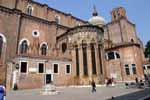
During the city walks through Venice one passes one church after the next. Each one of the churches seems to be even more pompous and more original than the previous one. It would be possible to write whole pages about the many churches of the city, such a lot of them are in Venice. Beside the basilica San Marco I was specially impressed by the Basilica San Giovanni e Paolo.
The church is located in the city district Cannarégio not far from the Fondamenta Nuove. It is a red brick building of giant dimensions. I did not find any possibility to make a picture of the church as a whole. Also the interior of the gothic basilica impresses with its huge dimensions. The church contains a huge arts collection with statues and paintings of namable Venecian artists. But the basilica has another meaning of a very different kind: 27 doges got their last resting place in this biggest gothic chapel.
Campo di Ghetto
In the city district Cannarégio that is located at the north there is the worrld famous Campo die Ghetto. It is actually not a specially nice place but its significance is so big that one should in any case visit this field (campo in Italian). Here, thousands of jewish business peoplen lived in the 16th century who got this area assigned by the senate of that time. The name Ghetto has its origin from the metal foundries (getti)that were settled here at that time.
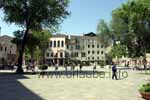
The jewish portion of population was isolated in this ghetto, as at nights, the portals were closed so that nobody could get in or out. Through this clever and natural arrangement of the surrounding channels, this area was easy to control and to bar. This ghetto of the 16th century was supposed to give a name to all other ghettos that followed in the course of the history and therewith we know that the term Getto of today has its origin from the Italian metal foundries.
Still today, numerous jewish families live around the Campo di Ghetto. From the former 9 synagogues in the ghetto, there are still 5 today. The Scuola Levantina Sinagoga is the most gorgeous one of the jewish chapels. It is located in the Ghetto Vécchio, thus in the "old" Ghetto.
Ponte dei Tre Archi
In the city district Cannarégio there is a unique bridge named Ponte dei Tre Archi at the very top of the channel Canal Di Cannaregio. The name already indicates the speciality of this bridge: it is a bridge for pedestrians that stands on both shores as also on two stilts, so that the bridge consists on three circled arcs.
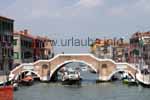
The bridge built in the 17th century is really beautiful and handsome, so that a walk alongside the Canal Di Cannarégio up to the bridge is worthwhile. But this bridge is not only beautiful and interesting but also unique: there is no other bridge in the whole city that is only approximately similar to this one; the architectural masterpiece was never copied; hundreds of other bridges have all only one big arch under which the ships can navigate through.
The reason for this uniqueness of the bridge with three arches is not due to the reason that the Venetian master builders were not able to built some similarly beatiful bridges over a channel, but that the Ponte dei Tre Archi resulted not to be feasible. It blocks the view and the shippping traffic, as it is always only possible that one ship navigates through the middle gate; the two side gates rather serve as an anchorage than a possibility to navigate through.
The walk from the Palazzo Lábia am Canal Grande alongside the shore of the Canal Di Cannarégio up to the Ponte dei Tre Archi is very interesting, as one walks a little aside from the usual tourist hype of the city. At the bridge there is, by the way, a vaporetto-station, so that one also can comfortably get back with a vaporetto and/or get immediately afterwards to the island Murano.
Palazzo Contarini del Bovolo
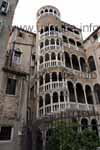
Amidst the city district San Marco there is an unusual palace named Palazzo Contarini del Bovolo. The palace is famous because of its snail-shell tower. For a small mite one can climb the tower stairs up to the highest floor. Durig the access one soon notices that is is a real staircase that communicates the floors with each other.
This palace that is approximately 500 years old is in any case a well worth seeing, specially because it clearly stands out from the rest palace buildings due to its snail-shell tower. But finding the Palazzo Contarini del Bovolo is a challenge, as the narrow blind alley is not easy to find although it apparently is located amidst San Marco. One has to walk over several bridges and through several alleayways in order to arrive finally at the Palazzo.
Riva Degli Schiavoni and Ponte Dei Sospiri
A walk alongside the Riva Degli Schiavoni belongs to the standard schedule of all visitors of Venice, as from the Piazza San Marco one anyway walks to the Palazzo Ducale and to the bridge Ponte Dei Sospiri, and then one is anyway already amidst the animated water front. Those who want can walk on this boardwalk up to the most southern tip of Venice. On the way to there, there are of course several bridges to be crossed.
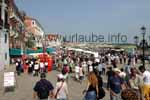
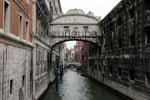
If on the first bridge umpteem people rush to the northern balustrade in order to shoot a picture, one knows that there must be something special. Between the Palazzo Ducale and the the Palazzo Delle Prigioni that is separated by a narrow channel there is one of the most famous bridges of the city, the Ponte dei Sospiri. The bridge is on one hand so special because it is not at the level of the street but on the level of the first floor, on hte other hand because it has a very special historical significance: on this bridge, prisioners were guided to the courtroom of the Palazzo Ducale. Also the famous Giacomo Casanova marched then over this bridge back into his prison cell in the Palazzo delle Prigioni.
On the Riva Degli Schiavoni there is a first-class tourist atmosphere; I think no local person would get lost here. The wide promenade is surrounded by small shops and mobile shops and there where there are no official selling places, the street merchants settle down and sell some typical tourists-"bargains" and handbags, necklaces or scarves. On the Riva Degli Schiavoni one is pushed, hit and displaced; here, one has to guard carefully for one's rucksack. But the further one goes from the Piazza San Marco in direction to the southwest, the smaller gets the inrush of tourists.

Back to the index Venice
Copyright: Patrick Wagner, www.tourist-guide.biz
|